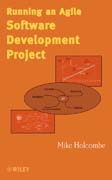
The use of agile software development processes continues to grow in both thesoftware development and project management sectors. This book explains how to run an agile software development project, concentrating on the practical, social, business, and management aspects, as well as the technical issues involved. Case studies provide real-world examples that illustrate how to deliver high-quality, high-value solutions to business clients. It is an excellent reference for practicing software developers, engineers, and project managers, anda valuable textbook for undergraduate and graduate students in software engineering and computer science. INDICE: Preface. Chapter 1: What is an agile methodology? 1.1 Rapid business change - the ultimate driver. 1.2 What must agile methodologies be able to do? 1.3 Agility - what is it and how do we achieve it? 1.4 Evolving software -obstacles and possibilities. 1.5 The quality agenda. 1.6 Do we really need all this mountain of documentation? 1.7 The human factor. 1.8 Some Agile Methodologies. 1.8.1 Dynamic Systems Development Method (DSDM). 1.8.2 Feature Driven Design (FDD). 1.8.3. Crystal. 1.8.4 Agile modeling. 1.8.5 SCRUM. 1.8.6 Summarytable. 1.9 Review. Chapter 2: Extreme Programming Outlined. 2.1 Some guiding principles. 2.2 The five values. 2.3 The twelve basic practices of XP. 2.3.1 Test first programming. 2.3.2 Pair programming. 2.3.3 On-site customer. 2.3.4 The planning game. 2.3.5 System metaphor. 2.3.6 Small, frequent releases. 2.3.7Always use the SIMPLEST solution that adds business value. 2.3.8 Continuous integration. 2.3.9 Coding standards. 2.3.10 Collective code ownership. 2.3.11 Refactoring. 2.3.12 Forty hour week. 2.4 Review. 2.5 The evidence for XP. 2.5.1Evidence for Test First. 2.5.2 Evidence for pair programming. 2.5.3 Evidence for XP. 2.6 Preparing to XP. Chapter 3: Foundations - people and teams workingtogether. 3.1 Software engineering in teams. 3.2 Personalities and team success. 3.3 Observations of team behaviour in XP projects. 3.4 Setting up a team. 3.5 Developing team skills. 3.6 Training together. 3.7 Finding and keeping a client for a university based project or a small business start up. 3.8 The organisational framework. 3.9 Planning. 3.9.1 PERT (Programme Evaluation and Review Technique). 3.9.2 Gantt Charts. 3.10 Dealing with problems. 3.10.1 Basic strategies. 3.10.2 When things go really wrong. 3.11 Risk analysis. 3.12 Review.Chapter 4: Starting an XP project. 4.1 Project beginnings. 4.1.1 Researching the business background. 4.1.2 Exploring the outline system description. 4.2 The first meetings with the client. 4.3 Business analysis and problem discovery. 4.4 The initial stages of building a requirements document. 4.5 Techniques for requirements elicitation. 4.6 Putting your knowledge together. 4.7 Getting technical. 4.8 Developing the requirements documents. 4.9 Specifying and measuring the quality attributes of the system. 4.10 The formal requirements document and system metaphor. 4.11 Contract negotiation. 4.12 Case study - the impact of organisational politics - learning from a failed project. 4.13 Review. Chapter 5: Identifying stories and preparing to build. 5.1 Looking at the user stories. 5.2 Collections of stories. 5.2.1 Pharmacovigilence. 5.2.2 Stamps system. 5.2.3 DELTAH (Developing European Leadership Through Action-learning in Healthcare). 5.3 User interfaces. 5.4 Communicating clearly with the customer and building confidence. 5.5 Demonstrating the non-functional requirements. 5.6 Estimating resources. 5.7 Review. Chapter 6: Bringing the system together as acoherent concept. 6.1 What is the problem? 6.2 A simple common metaphor. 6.3 Architectures and patterns. 6.4 Finite state machines. 6.5 Extreme modelling (XM). 6.6 Multiple stories and XXMs. 6.7 Building the architecture to suit the application - a dynamic system metaphor. 6.8 Another look at estimation. 6.9 Review. Chapter 7: Designing the system tests. 7.1 Preparing to build functional test sets. 7.1.1 Tests and testing. 7.1.2 Testing from a model. 7.1.3 Developing the model. 7.2 Testing with the Data in mind. 7.3 The full functional system testing strategy. 7.4 The thinking behind the system test process. 7.5 Design for test. 7.6 Test documentation. 7.7 Non-functional testing. 7.8 Testing internet applications and web sites. 7.9 Review. Chapter 8: Units and their tests. 8.1 Basic considerations. 8.2 Identifying the units. 8.3 Unit testing. 8.4 More complex units. 8.5 Automating unit tests. 8.5.1 Writing Unit Tests in JUnit. 8.6 Documenting unit test results. 8.7 Review. Chapter 9: Evolving the system. 9.1 Requirements change. 9.2 Changes to basic business model and functionality. 9.3 Dealing with change - refining stories. 9.3.1 Changes to the underlying data model. 9.3.2 Changes to the structure of the interface, perhaps the introduction of a new. 9.3.3 Adding a new function. 9.3.4 Changing the functionality of a function. 9.4 Changing the model. 9.4.1 Changing a process. 9.4.2 Removing states. 9.4.3 Adding states. 9.4.4. Adding a complete machine. 9.4.5 Adding processes. 9.5 Testing for changed requirements. 9.6 Refactoring the code. 9.7 Estimating the cost of change. 9.8 Summary. Chapter 10: Documenting and delivering the system. 10.1 What is documentation for and who is going to use it? 10.2 Coding standards and documents for programmers. 10.3 Coding standards for Java. 10.4 Maintenance documentation. 10.5 User manuals. 10.6 Versioncontrol. 10.6.1 The project archive. 10.6.2 Naming conventions. 10.7 Deliveryand finalisation. 10.8 Summary. Chapter 11: Reflecting on the process. 11.1 Skills and lessons learnt. 11.2 The XP experience. 11.3 Personal and Team Assessment. 11.4 Summary. 11.5 Conundrums - discussion. Chapter 12: Lifestyle matters. 12.1 Keeping fit. 12.1.1 Correct sitting position. 12.1.2 Combating RSI. 12.2 General well-being. 12.3 Mental preparation. 12.4 Diet. 12.4.1 Diet and Brain function. 12.4.2 Summary of dietary information. 12.5 Music and work. 12.6Conclusions and summary. References. Web sites. Index.
- ISBN: 978-0-470-13669-0
- Editorial: John Wiley & Sons
- Encuadernacion: Cartoné
- Páginas: 344
- Fecha Publicación: 21/11/2008
- Nº Volúmenes: 1
- Idioma: Inglés
